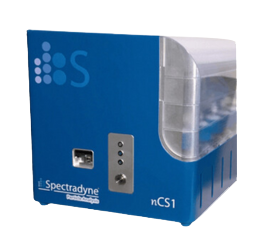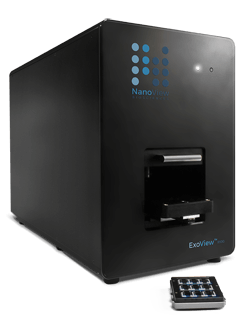Our Services
What We Offer
Description and Pricing
What We Offer
Description and Pricing
nCS1 by Spectradyne

This instrument uses a technique called resistive pulse sensing (RPS) to measure your EV size distribution and concentration, which is something that needs to be calculated and reported for every EV sample you analyze so we made sure to provide a reliable and user-friendly instrument in our core.
RPS uses a nanopore (with sizes ranging from 80-900 nm depending on your sample) with an electric current flowing through a buffer. Your sample then runs through this pore and the amount that each EV particle disrupts this current is directly proportional to its size. It measures single EVs at a time, and if there are aggregates, they will likely clog up the pore, at which time the machine will automatically stop and allow you to reverse the flow. Your sample is also kept separate from the running buffer so there is no dilution or contamination.
Advantages:
Caveats:
- Anything lower than about 65nm is difficult to distinguish from electrical background noise.
Prices as Resource
- No technical assistance Academic: $45 | Non-Academic: $65
- Assistance/training Academic: $60 | Non-Academic: $80
Notes: $10 off each rate if the user brings disposable cartridges from their lab
Ultracentrifugation (UC): Extracellular Vesicle Isolation
UC is used for initial separation of EVs from biofluid through differential and sequential spins, including a 20,000 x g spin for larger microvesicles and concluding with a high-speed spin for those isolating “small EVs” or “exosomes” (30-150nm in size). After getting your initial EV pellet (whether high speed or low speed), UC can also be used to create a density gradient, to separate your EVs from any non-vesicular contaminating factors in your pellet.
Prices as resource:
- No technical assistance Academic: $25 | Non-Academic: $40
- Assistance/training Academic: $40 | Non-Academic: $855
Prices per sample as full service:
- Academic: $70 | Non-Academic: $90
Leprechaun Chip Array by Unchained Labs

For every EV preparation you make, you must characterize at least 2-3 “markers of those EVs. For small EVs the most common are the tetraspanins CD63, CD81 and CD9. The company NanoView Biosciences created a platform called ExoView that was renamed the Leprechaun when Uchained Labs acquire NanoView. It can simultaneously analyze EV surface expression of all three markers. The advantage is that you can put a small volume (35ul) of your biofluid (plasma, cell culure supernatant, etc) directly onto the plate for analysis without any pre-processing for EV separation. Analysis only takes one day and a half (overnight incubation, wash, and plate reading). EV preparation you make, you must characterize at least 2-3 “markers of those EVs. For small EVs the most common are the tetraspanins CD63, CD81 and CD9. The advantage here is a quick analysis of these essential markers that are necessary to evaluate for every EV sample and biofluid you work with. It is very sensitive and usually it doesn’t require EV enrichment thus giving a native profile of the tetraspanins in the biofluid without any potential bias of the enrichment method. In addition to the tetrasapnin kits it is possible now to customize the capture chip with the marker of interest. Finally, a lentivirus kit is available to differentiate the portion of full lentivirus from empty one with or without the presence of tetraspanin.
Prices as Resource:
- No Technical Assistance Academic: $80 | Non-Academic: $100
- Assistance/training Academic: $100 | Non-Academic: $120
Prices Per Sample as Full Service:
- Academic: $120 | Non-Academic: $160
- Cost of chips need to be added. This varies depending on the kit
Prices may vary if custom capture chip is used
NanoFCM: EV analysis by Flow Cytometry
This instrument is a state-of-the-art flow cytometer with 3 lasers, superior optics, and low-noise electronics, this instrument detects and analyzes functional nanoparticles (35-1000 nm) at the single particle level. By analyzing ultralow scattered light from single nanoparticles, it provides high-resolution size distributions comparable to electron microscopy in 1-2 minutes. The size is extrapolated from two standard curves made of silica beads of 68, 91, 113 and 155 nm and 155, 270 , 535 and 850 nm respectively. Furthermore, it is possible to simultaneously measure multiple parameters within a sample, including a variety of surface proteins, nucleic acids, and lipids.
This is ideal for identification of EV subsets and quantification based on fluorescence-based detection, not just light scatter. The advantage is a single-day, high throughput analysis of EVs and the ability to use your own antibodies to your molecules and species of interest.
Prices as Resource:
- No technical assistance Academic: $80 |Non-Academic: $100
- Assistance/training Academic: $100 | Non-Academic: $120
Prices Per Sample as Full Service:
- Academic: $65 | Non-Academic: $80
CytoFLEX nano (Beckman Coulter)
The Nano CytoFLEX is a cutting-edge flow cytometer that combines the principles of flow cytometry applied to the study of nano particles. It enables the analysis of particles at the nanoscale (less than 1 mm), providing valuable information about their size, composition, and surface properties. The CytoFLEX nano Flow Cytometer offers:
- High sensitivity to detect and characterize nanoparticles at least as small as 40 nm (based on polystyrene beads).
- High resolution to accurately distinguish particles of similar size within 10 nm difference (based on silica beads), and ability to characterize low-abundance targets in a heterogeneous population.
- Consistency in instrument performance and data analysis, thanks to a very detailed QC process and fluorescence Sensitivity Monitor, as well as multiple options for automated on-board cleaning to prevent carry-over between samples.
- High flexibility to design experiments, thanks to 5 side scatter parameters and 6 fluorescence channels. It enables the detection up to 11 independent parameters at the same time on the same sample.
The CytoFLEX nano Flow Cytometer is equipped with four lasers: Violet l 405 nm, Blue l 488 nm, Yellow l 561 nm, and Red l 638 nm. Two Wavelength Division Multiplexers (WDMs), one for scatter optical filters (VioletSSC1, VioletSSC2, BlueSSC, YellowSSC and RedSSC) and one for fluorescence optical filters (V447, B531, Y595, R670, R710, R792)
Prices as resource:
- No technical assistance Academic $90 | Non-Academic $110
- Assistance/training Academic $110 | Non-Academic $130
Prices per sample as full service:
- Academic: $65 | Non-Academic: $80
The ZetaView Instrument
The ZetaView instrument by ParticleMetrix can measure total EV concentration and size distribution by Nanoparticle Tracking Analysis (NTA) and also the surface charge of the particles (zeta potential). The surface charge of EVs has been linked to differences in biological behavior and is another parameter to characterize EVs for academic reviewers who require extended EV characterization for journal publications. Using the relationship between electrophoretic mobility of the particle and zeta potential, the ZetaView machine measures the zeta potential of your particles while also using NTA methods to determine EV size distribution with improved resolution and less bias towards larger particles than Nanosight. The caveat of measuring zeta potential is that it doesn’t tell you about the concentration of EVs in the sample or the EV size, but with the same ZetaView machine you can easily perform NTA and fluorescent NTA to get your concentration and size. The ZetaView machine from Particle Metrix is capable of measuring fluorescently labeled EVs, but GFP, Alexafluor-conjugated antibodies, and membrane dyes are best. FITC-conjugated antibodies photobleach too quickly for detection.
Advantages:
- Zeta potential, total NTA analysis and fluorescent NTA all in one machine
- Improved resolution and less bias towards larger particles than the Nanosight
- Less parameters for the user to manually set compared to Nanosight, increasing the amount of reproducibility between different samples and users
- With one sample run using as low as 1-3 ul of your original EV sample, you can measure total EV size and concentration by light scatter NTA, zeta potential, and fluorescence NTA excitable by 488nm and 550nm lasers.
Caveats:
With particles below 50nm, it is still difficult to fully resolve what is background noise versus what is an actual particle, since very small EVs do not scatter light strongly. We recommend with EV samples from a new source to supplement your characterization with TEM analysis (see “integral partners” for more information on scheduling this).
Prices as resource
- No technical assistance Academic: $50 | Non-Academic: $70
- Assistance/training Academic: $65 | Non-Academic: $95
Prices per sample as full service
- Academic: $30 | Non-Academic: $45
Consultation
Consultation: study concepts, data analysis, downstream experimental design and publication/grant support
Part of our mission at the EV Core facility is to maximize the quality and success of publications and grant applications. We provide consultation services to provide guidance and support in experimental design, publication preparation and can also provide letters of support for grant applications.
Per hour: $25
ZetaView and nCS1 Spectradyne price combo, we offered a special offer to measure particle size distribution and particle counts with both instruments for a price of $80 per sample
Requesting Service
If you are interested in requesting services from the Penn Vet Extracellular Vesicle Core, please fill out this form to contact Luca Musante, PhD director of the EV core facility.
